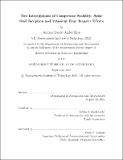Two investigations of compressor stability : spike stall inception and transient heat transfer effects
Author(s)
Kiss, Andras Laszlo Andor
DownloadFull printable version (5.838Mb)
Other Contributors
Massachusetts Institute of Technology. Department of Aeronautics and Astronautics.
Advisor
Zoltán S. Spakovszky.
Terms of use
Metadata
Show full item recordAbstract
Two investigations of current problems in the field of compressor stability are presented. The first is of the formation of spike-type rotating stall precursors. Recently, high fidelity computations have attributed pre-cursor formation to a leading-edge separation and consequent shedding of vorticity near the rotor tip due to high incidence. This hypothesis is assessed via experiments in a low-speed compressor and a linear cascade, supported by unsteady computations. Fast-response pressure measurements at the blade tip show spike pre-cursors propagating in the cascade environment at a rate consistent with the low-speed compressor. The cascade design produces high incidence at the mid-span and fast-response velocity measurements show pre-cursor formation away from the tip region. Unsteady computations confirm leading-edge separation and vortex shedding in both the compressor and cascade. A single blade was instrumented with smoke injection at the leading-edge to visualize the separation and the effect of Reynolds number on pre-cursor formation was quantified to facilitate smoke visualization. The resultant visualizations confirm the leading-edge separation and propagation of shed vorticity. The second investigation is of the effects of heat transfer between the compressor structure and gas path during transient operation. A mean line model of an advanced, high pressure ratio compressor is extended to include the effects of heat transfer. Diabatic, transient calculations show a 9.9 point reduction in stall margin from the adiabatic case. 2.5 points are attributed to the effect of heat transfer on blade row deviation and the remainder is attributed to stage rematching. Heat transfer increases loading in the front stages and the stalling pressure ratio is set by front stage stall, suggesting heat transfer effects are greater for compressors with highly loaded front stages. Sensitivity studies of heat flow rate and deviation show a linear dependence of stall margin loss for ratios of heat flow rate to inlet stagnation enthalpy flux much less than unity.
Description
Thesis: S.M., Massachusetts Institute of Technology, Department of Aeronautics and Astronautics, 2015. This electronic version was submitted by the student author. The certified thesis is available in the Institute Archives and Special Collections. Cataloged from student-submitted PDF version of thesis. Includes bibliographical references (pages 139-142).
Date issued
2015Department
Massachusetts Institute of Technology. Department of Aeronautics and AstronauticsPublisher
Massachusetts Institute of Technology
Keywords
Aeronautics and Astronautics.